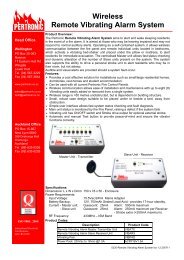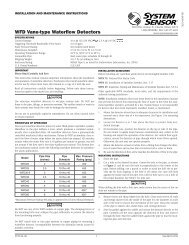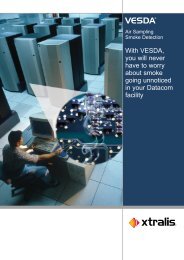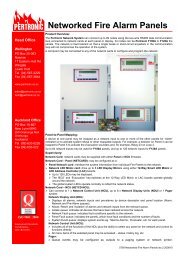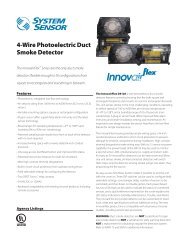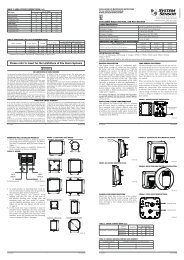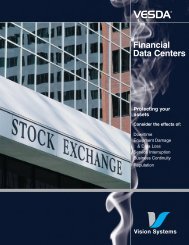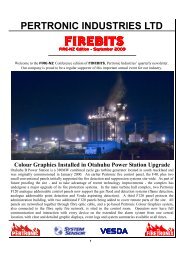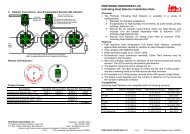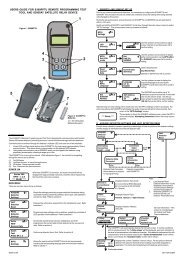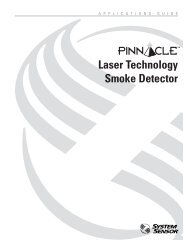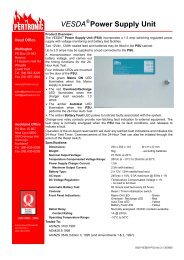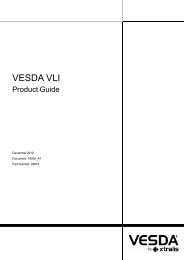Aspirating Smoke Detection
Aspirating Smoke Detection
Aspirating Smoke Detection
You also want an ePaper? Increase the reach of your titles
YUMPU automatically turns print PDFs into web optimized ePapers that Google loves.
<strong>Aspirating</strong><br />
<strong>Smoke</strong> <strong>Detection</strong><br />
Clean Rooms<br />
Protecting high value<br />
assets and production in:<br />
Semiconductor/Wafer Fabs<br />
Electronic Device Manufacturing<br />
Research &<br />
Development Facilities<br />
Process, Assembly<br />
& Inspection Areas
Clean Rooms and the<br />
challenge of protecting them<br />
from the threat of fire.<br />
High risk and expensive<br />
consequences<br />
There are many factors to consider when<br />
protecting a clean room from fire:<br />
• They contain high value equipment<br />
• Work in-process is very sensitive to damage<br />
and of high value<br />
• Highly flammable liquids and gases are present<br />
• The air exchange rate can be up to 600 changes<br />
per hour, causing smoke dilution and supplying<br />
oxygen to a fire<br />
• There are many electronic components in a<br />
clean room. Electrical faults are a major cause<br />
of clean room fires<br />
• Some processes require temperatures in<br />
excess of 800°C, posing a fire risk.<br />
The high cost of contamination<br />
and lost production<br />
The damage from a clean room fire can be<br />
thermal (from flame/heat) and non-thermal (smoke<br />
contamination and corrosion). Non-thermal damage<br />
can be far greater than the thermal damage as<br />
clean rooms are critical to the manufacturing<br />
process and often are not duplicated. Even a small<br />
fire with relatively low physical damage can result<br />
in significant loss of production while the room is<br />
being decontaminated.<br />
Why spot-type smoke detectors don’t<br />
work in clean rooms<br />
<strong>Smoke</strong> doesn’t reach the ceiling<br />
<strong>Smoke</strong> in a clean room will be dragged along with the<br />
air flow and may never reach spot detectors on the<br />
ceiling. A fire has to be quite large for the smoke to<br />
have enough thermal energy to escape the air flow and<br />
travel upwards. By that time, considerable thermal<br />
and non-thermal damage has occurred.<br />
High cost of ownership<br />
Some fire codes (e.g. NFPA 75) require spot detectors<br />
in rooms with high air velocities to be installed at close<br />
spacing. This not only increases the installation costs,<br />
but demands high cost of ownership. Each spot detector<br />
has to be routinely tested and maintained—within the<br />
clean room, potentially halting production.<br />
Clean room VESDA system installations<br />
Fresh Air<br />
Design 1<br />
Example<br />
A fire that occurred in a 465 m 2 clean room was<br />
extinguished by a single sprinkler, but it took 74<br />
days to clean up and resume operations.<br />
In a typical wafer fab fire, losses due to business<br />
interruption are typically 30% of the total loss,<br />
which can run to millions of dollars 1 .<br />
1. From a 1995 study by Munich Reinsurance company of Canada of 21 semiconductor plants in Asia.<br />
Sub-Fab Area<br />
Cross Section of a Clean Room,<br />
illustrating 2 VESDA installation designs
Reducing the risk by using very early<br />
warning smoke detection<br />
A key component in an effective fire protection system<br />
for a clean room is very early warning smoke detection.<br />
Detecting smoke as early as possible minimises<br />
contamination of the clean room and allows the most<br />
time to respond to a threat.<br />
VESDA aspirating smoke detectors provide the very<br />
early warning that is critical in a clean room. They<br />
continuously draw air through a network of pipes back<br />
to the detector, instead of waiting for the smoke to arrive<br />
at the detector. This makes them extremely sensitive.<br />
Regulatory information<br />
“<strong>Smoke</strong> detection and control are essential to<br />
maintaining clean room integrity in the event<br />
of a fire. Prompt detection of smoke at very<br />
low concentrations, and its subsequent removal,<br />
is needed to minimise contamination.<br />
Highly sensitive air sampling or linear beam-type<br />
smoke detectors are needed as conventional<br />
photoelectric and ionisation-type smoke detectors<br />
are not sensitive enough for clean rooms.”<br />
FM Global<br />
Loss prevention data sheet 7-7<br />
Semiconductor Fabrication Facilities<br />
Airflow<br />
Equipment<br />
e.g. Wet Bench<br />
Station<br />
Fire Growth Curve<br />
The progression of fire growth over time. A VESDA system detects a fire<br />
at the incipient stage, avoiding damage and lost production.<br />
Pre-Filter<br />
Sampling<br />
Holes<br />
Airflow<br />
Floor Void<br />
Design 2<br />
Sample pipe in the floor void beneath a raised access floor will<br />
capture smoke as it is carried by the airflow.<br />
Ceiling Void<br />
A reference detector can detect external pollution entering the<br />
airflow via the fresh air make-up supply<br />
The ceiling-space can be monitored by installing VESDA sample<br />
pipe above the ceiling<br />
Include the air volume exchange rate when calculating the area<br />
coverage of a smoke detector<br />
Clean Room<br />
Install sampling points in close proximity to identified risks<br />
(i.e. equipment)<br />
Use shorter sampling pipe networks to reduce the time taken<br />
for the smoke to reach the detector & place sampling points in<br />
the direct path of the airflow<br />
UPS Power Room<br />
Install the detector units outside the clean room, so they can be<br />
maintained without disrupting production<br />
CRAC<br />
unit<br />
Consider protecting other areas in the fab such as service<br />
corridors and ducted air plenums below a raised access floor<br />
Adding VESDA System Management (VSM4) software allows<br />
monitoring and control of smoke detectors from a Central<br />
Monitoring Station or Emergency Control Room
Xtralis’s global network of offices<br />
and representatives means that<br />
help is soon at hand<br />
Why use a VESDA system<br />
When selecting an aspirating smoke detection system for a clean room, consider:<br />
Look for Why What VESDA offers<br />
The best sensitivity<br />
A wide sensitivity range<br />
A redundant peer-to-peer<br />
communications network<br />
Multiple programmable alarm thresholds<br />
Event log and reporting<br />
A wide product range<br />
Absolute calibration<br />
Monitoring of particles less than<br />
10 microns diameter<br />
Monitoring and control of smoke detectors<br />
from a Central Monitoring Station or<br />
Emergency Control Room<br />
An accredited global distribution and<br />
support network<br />
To achieve the earliest possible warning<br />
of a fire<br />
So that detection levels can be set to suit<br />
the environment, avoiding false alarms<br />
To give you flexibility in positioning and<br />
programming detectors and display modules<br />
So that the response can be appropriate<br />
for the stage of the fire, from ‘Investigate’ at<br />
the first alarm through to ‘Activate de-smoke<br />
system’ or ‘Release suppression’ at the<br />
fourth alarm level<br />
A forensic tool for investigating faults, alarms,<br />
user actions and smoke trends.<br />
So that there’s a product to suit any size<br />
area that you want to protect… from a large<br />
open manufacturing floor to within the<br />
confines of production equipment<br />
Ensures repeatable and reliable detection<br />
of very slow growth incipient fires<br />
Ensures that smouldering fires in a clean<br />
room are detected early<br />
Allows response to be controlled and<br />
monitored from a central point by trained<br />
operators<br />
So you get the right technical advice when<br />
you need it<br />
VESDA can detect smoke at 0.005%<br />
obscuration per metre<br />
VESDA detectors have a sensitivity range<br />
of 0.005%–20% obscuration/m<br />
The VESDAnet communication network<br />
allows you complete installation flexibility<br />
VESDA has 4 programmable alarm levels<br />
Each VESDA detector has an event log that<br />
stores the last 18000 events<br />
VESDA has the widest product range on<br />
the market<br />
VESDA is the only air sampling smoke<br />
detector with Absolute calibration<br />
VESDA detectors can detect particles<br />
smaller than 0.1 microns<br />
Using VESDA System Management (VSM4)<br />
software, every VESDA detector can be<br />
controlled and monitored remotely.<br />
All distributors of VESDA products are<br />
factory-accredited<br />
Some of the Clean Rooms that are protected by VESDA<br />
IBM Texas Instruments Samsung Semiconductors Applied Materials Inc.<br />
Intel Seagate Honeywell Microswitch Fujitsu<br />
Motorola Peregrine Semiconductors AT&T Microelectronics Hyundai Semiconductors<br />
Komatsu Phillips Sony TSMC<br />
AU Optronics LG Electronics China Picture Tube (CPT) Chi Mei Operations (CMO)<br />
Approvals<br />
CCCf<br />
Need more information<br />
Call the Xtralis office closest to you, as listed below. Visit www.xtralis.com/vesda to access information about the<br />
VESDA smoke detector product range and our Clean Room Design Guide.<br />
www.xtralis.com<br />
The Americas +1 781 740 2223 Asia +852 2297 2438 Australia and New Zealand +61 3 9936 7000<br />
Continental Europe +41 55 285 99 99 UK and the Middle East +44 1442 242 330<br />
The contents of this document are provided on an “as is” basis. No representation or warranty (either express or implied) is made as to the<br />
completeness, accuracy or reliability of the contents of this document. The manufacturer reserves the right to change designs or specifications<br />
without obligation and without further notice. Except as otherwise provided, all warranties, express or implied, including without limitation any<br />
implied warranties of merchantability and fitness for a particular purpose are expressly excluded.<br />
This document includes registered and unregistered trademarks. All trademarks displayed are the trademarks of their respective owners.<br />
Your use of this document does not constitute or create a licence or any other right to use the name and/or trademark and/or label.<br />
This document is subject to copyright owned by Xtralis AG (“Xtralis”). You agree not to copy, communicate to the public, adapt, distribute,<br />
transfer, sell, modify or publish any contents of this document without the express prior written consent of Xtralis.<br />
Document: 11594_04



